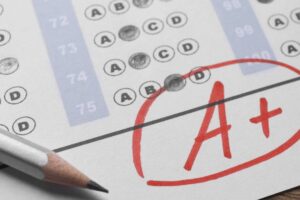
The Em Dash Debate We Should Be Having (opinion)
It seems a day does not go by without seeing someone confidently assert on social media that an em dash is not an indicator of AI-written text. Those social media posts are in response to an ongoing debate about whether or not the em dash is a dead giveaway of writing produced by generative AI. Some writers and academics resent that their cherished em dash is getting a bad rap. As one writes, “You can take my em dash from my cold, dead hands.”
As a writer who does not use AI, I understand the frustration with the recent em-dashes-are-a-sign-of-AI-use bandwagon. I certainly do not want to be accused of using AI whenever I use an em dash. And as an English composition instructor who wants students to write without using AI, I understand how easy it can be to latch on to a purported way of quickly identifying AI-generated writing.
But rather than get angsty about it as a writer or accusatory as an instructor, I am choosing to view the current em dash–AI kerfuffle as serendipitous. AI might be new, but a controversy about em dash usage is not, and the current debate provides an opportunity to try and temper its overuse—again.
A year before what is recognized as the birth of the World Wide Web, Robert Bringhurst, in The Elements of Typographic Style, took a shot across the bow at em dash usage. An em, in typesetting vernacular, is a square measurement where, as Bringhurst explains, “One em is a distance equal to the type size”: therefore “the em is a sliding measure.” In other words, an em is not a fixed horizontal length; it is a horizontal space proportional to the point size. So if someone is using 12-point type, then one em would be 12 points horizontally. Half of an em is called an en. So when using 12-point type, an en is six points horizontally.
In post-typesetting days, Bringhurst recommends that spaced en dashes – like this – be used—instead of nonspaced em dashes like this—to set off phrases within a sentence. Although he did see valid uses for the em dash, such as for written dialogue, Bringhurst contends that “the em dash is the nineteenth-century standard” and “too long for use with the best text faces” in modern times. According to Bringhurst, just as we no longer put two spaces after a period at the end of a sentence (a holdover from typesetting and later typewriter days), the em dash “belongs to the padded and corseted aesthetic of Victorian typography.”
While Bringhurst’s suggestion was to replace ungainly em dashes with en dashes to offset sentence interruptions, continuing debates over the em dash focus on limiting such interruptions in the first place.
In 2011, Philip Corbett of The New York Times noted an increasing use of the em dash in newspaper articles. The problem? The em dash “can seem like a tic; worse yet, it can indicate a profusion of overstuffed and loosely constructed sentences, bulging with parenthetical additions and asides.”
That same year, Noreen Malone, writing for Slate, demonstrated how the em dash “discourages truly efficient writing” and “disrupts the flow of a sentence.” Granted, a purpose of the em dash is to interrupt, but the problem was not just that people were interrupting their writing a lot, but that they were also using it in place of better-suited punctuation. Rather than figuring out the best punctuation to use for specific writing situations and purposes, people were using the em dash as the jack-of-all-trades but master of none. Would it be best to use a comma, semicolon, period or colon? Who cares? Just throw in the exotic em dash.
Now, as a direct result of its overuse as a substitute for more apt punctuation and its ubiquity in the written material that became the training data for LLMs, it is no surprise that the em dash is frequently showing up in AI-generated writing. There is no indication, as far as I am aware, that AI is intentionally trying to wrest the em dash from those who use it ethically and responsibly. But AI is fortuitously forcing us to grapple with the cavalier use of the em dash across recent decades. So what can writers and teachers do about it?
As writers, we have a roster of punctuation marks from which to draw upon for specific purposes, and our choices can bring better clarity to our writing and demonstrate writerly skill. As Andi Zeisler points out in “AI can’t have my em dash,” em dashes “don’t really need to be there,” “aren’t integral to sentence structure” and “are decidedly extra.” That does not mean that writers must lay down all their em dashes and surrender them to AI. But as writers, we should be connecting thoughts smoothly and taking care to use just the right punctuation for a specific purpose while resisting the allure of an em dash that might save us the expert work of choosing the precisely placed period, comma, parenthesis, semicolon or colon.
As teachers, we should not automatically think a student used AI when we see an em dash. I reject the notion that em dashes are a telltale of AI-written text. Whenever I suspect that something I am reading was written by AI, it is due to the writing style, not the presence of an em dash. Regardless, whether its use is attributable to AI or simply disjointed or imprecise writing, the presence of an em dash provides an opportunity to teach students how to better connect their thoughts in their writing and more carefully consider when and how to use the best punctuation for different situations.
Richard Mitchell (a.k.a. the Underground Grammarian) once wrote, about the word “input,” that “a word that means almost anything means almost nothing” and “no longer makes any useful distinction.” The same can be said about the em dash. It might be that the em dash is necessary in select situations, but in most others it is not.
Source link


